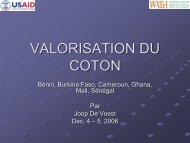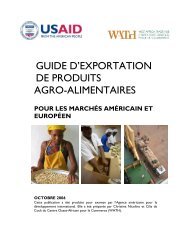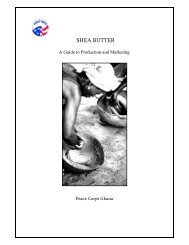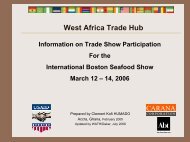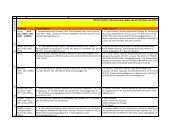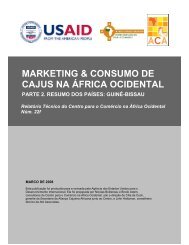A Brief Introduction to Textile Processing - AGOA Export Toolkit
A Brief Introduction to Textile Processing - AGOA Export Toolkit
A Brief Introduction to Textile Processing - AGOA Export Toolkit
You also want an ePaper? Increase the reach of your titles
YUMPU automatically turns print PDFs into web optimized ePapers that Google loves.
Figure 5. Common woven fabric structure<br />
Woven fabrics. Woven fabrics are the most commonly used for apparel,<br />
though knit fabrics have become increasingly popular because of the<br />
comfort from their inherent stretch. Woven fabrics are produced by<br />
intertwining two yarns in a perpendicular orientation. The yarns (ends) that<br />
run the length of the fabric are called “warp” yarns, and may be thicker and<br />
usually must be stronger than the crosswise yarns. The latter are called<br />
“weft” or “filling” yarns.<br />
_________________________________________________________________<br />
_________________________________________________________________<br />
_________________________________________________________________<br />
_________________________________________________________________<br />
warp yarn<br />
Weft yarn<br />
Figure 6. Warp and weft directions<br />
Woven fabrics are described by the type or pattern of weave (e.g. plain weave, twill, satin,…) and by<br />
the thread count. Thread count is denoted by the number of warp and weft yarns per cm or inch<br />
(depending upon the country where the fabric is manufactured). It is stated as warp ends X weft<br />
ends, for example, 31 x 17 (31 warp ends per cm and 17 weft ends per cm, a common thread count<br />
for 100% cot<strong>to</strong>n fabric.) In some countries, such as the United States, inches may be used instead of<br />
cm. In the example above, in the US version of the thread count (based in inches) would be would<br />
be 78 x 44 (both numbers multiplied by 2.54). One also frequently runs across goods described as 80<br />
thread count goods this might be a 50 x 30 or a 40 x 40 or any other combination where the sum of<br />
warp + fill = 80. Plain and basket weaves have a balanced appearance, with warp and weft yarns<br />
clearly running at right angles <strong>to</strong> each other. Twill weaves, though still formed with warp and weft<br />
yarns running at right angles, have a distinctive diagonal appearance. Satin weaves have a smooth,<br />
shiny surface. Entire books have been written on the different weaving patterns.<br />
Knit fabrics. Of the three types of fabrics, knit fabrics have the most<br />
stretch, owing <strong>to</strong> the way in which yarns are intertwined in loops <strong>to</strong><br />
form the fabric. Knit fabrics are constructed on a knitting machine. They<br />
may be formed either by intertwining the yarn back and forth across the<br />
width of the fabric (weft knits), or intertwining it parallel <strong>to</strong> the length of<br />
the fabric (warp knits). Hand knitting is a good example of artisanal scale<br />
weft knitting. Depending upon the type of machine and fabric, yarn may<br />
be fed in<strong>to</strong> the knitting machine directly from a individual cones of yarn<br />
placed on a creel, or may be first wound from a creel on<strong>to</strong> a warp beam<br />
and then fed in<strong>to</strong> the knitting machine.<br />
Figure 7. Typical knit fabric construction<br />
In the case of either weft or warp knits, these fabrics have less dimensional stability than woven<br />
fabrics, meaning they lose their shape more easily and may curl, become dis<strong>to</strong>rted, or stretch out. In<br />
recent years stretch fibers have been widely used in knit fabrics <strong>to</strong> provide “memory” so that when a<br />
Prepared by Margaret Bishop and Brent Smith for the West Africa Trade Hub 8/04 7



